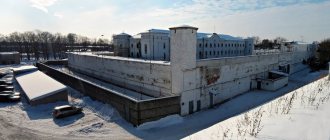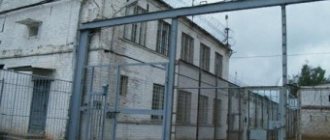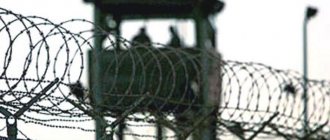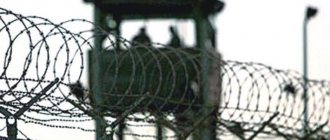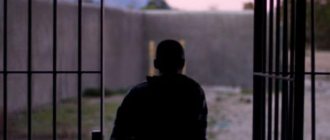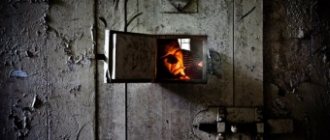White Swan Prison
White Swan is a special and strict regime colony. Throughout its existence, there has not been a single escape here.
White Swan is the unofficial name of a special regime correctional colony in the city of Solikamsk (the official name is VK-240/2 or IK-2 of the Federal Penitentiary Service of Russia in the Perm Territory). One of the toughest regimes in the correctional system. Variants of the unofficial name came from different versions: from the color of the walls, or, more plausibly, from the way prisoners moved around the prison: leaning forward (almost 90 degrees) with their arms thrown behind their backs, the so-called “swan”.
Prison "White Swan" in the city of Solikamsk
Or there is another version of the name from the fact that in the prison yard there is a monument to white swans. The famous terrorist Salman Raduev (died in 2002) and other especially dangerous criminals were kept in this prison. There are two famous zones in Russia that many have heard about. These are the Orenburg “Black Dolphin” and “White Swan”. It was this colony, located in the Perm region, that debunked the myth about the beautiful and free life of thieves in prison. Here, dozens, hundreds of thieves in law were broken and “uncrowned.”
Photo of the White Swan prison
Today, within these walls there is one of the Russian “life-long” zones, as well as strict and special regime colonies. In January 2008, the famous colony “BL”, as well as other colonies that in 1938 were part of the administration of the Usolsky camps, celebrated their 70th anniversary.
"White Swan", black mode
The harsh history of Moscow's most famous prison
The city of Solikamsk in the Perm region is famous throughout the country for two things - mines and the White Swan. The lyrical name hides a colony (IK-2) with the strictest regime for those sentenced to life - serial killers, maniacs, terrorists. Why "White Swan"? Three versions. The first is because of the figures of birds scattered around the territory as a weather vane, patterns on the fence, and sculptures. The second explanation is associated with thieves in law: supposedly criminal generals called their stay here their swan song. According to the third version, "White Swan" refers to the position in which the prisoners moved: the body was bent, the hands were handcuffed and raised behind the back.
Although they say they no longer drive prisoners this way, the rules are still as strict as possible. When the viewing window in the cell is opened, the convicts jump up facing the wall, arms raised, palms turned outward - and do not move. Walk - 1.5 hours, visit with relatives - 4 hours twice a year, after 10 years of approximately behavior in the colony, long meetings are possible.
In total, there are about 100 cameras in the “White Swan”, near each there are terrifying signs: “Killed a family of four with extreme cruelty” or “Rape and murder of minors.” In addition to the “wall dossiers,” there are cameras everywhere. “The security has surveillance cameras for living and inanimate objects along the entire perimeter of the colony; in the center of the institution there are several hidden mini-cameras that constantly record what is happening,” according to the colony’s website. It is impossible to escape, there is only one way out - to the cemetery. Although the history of the prison knows four cases of replacing a life sentence with a fixed term, the last review of a case with such an outcome dates back to 2011.
Colony "White Swan". Photo: Alexey Zhuravlev, www.perm.kp.ru
Prison love
Meanwhile, some of those sentenced to life in the “White Swan” manage to create families: they get married right in the zone, having met their chosen ones through acquaintances or by correspondence. However, for some semblance of family life, a prisoner must first serve 10 years - and so that there are no complaints against him. If the conditions are met, the prisoner is transferred from special to more lenient conditions of detention and is allowed long-term visits, including with his wife.
Among the scarce types of recreation in the White Swan, reading is considered the most accessible and popular. The colony has a large library of five thousand books, from which every inmate can find something to his liking. And some of the convicts even manage to receive a higher education in absentia behind bars - all these things help prisoners not to degrade in the harsh conditions of the zone.
Shot: Vesti Perm ONLINE / YouTube
Despite all the severity, “White Swan” can be considered one of the most progressive colonies for lifers. It was there that prisoners first had the opportunity to receive help from a psychologist, meetings with whom take place in a special recreation room. There, prisoners can not only talk with a specialist, but also simply relax, watch TV and sit on a soft sofa and armchairs. After constantly being in cells with hard berths and wooden benches, prisoners value the opportunity to visit the rest room very highly.
Thieves in law in the White Swan colony
Thieves in law who died in prisons and colonies
"White Swan" was created in 1938 as a camp for political criminals. In 1955, the colony was repurposed as a place for the re-education of thieves in law. The name of Vasily Snytserev, a major general who broke authority, is connected with this time period. During the years of his service, five thousand criminals passed through the White Swan: many of them lost their status in the criminal hierarchy, and 130 thieves in law renounced their crown.
They “processed” criminals who considered themselves special using different methods: they were forced to work, and for disobedience they were sent to a detention center; they found a serious illness among the prisoners and entered into an agreement: treatment - after refusing the “corona”; thieves in law were put in so-called “press huts”, where they were dealt with by prisoners supporting the prison administration.
The most famous local thief in law who has not renounced his title is Vasya Brilliant, who ended up in the White Swan after 30 years in prisons and camps. Here, in 1985, shortly after his arrival, he died, according to a medical report, of a heart attack. The grave of the thief in law with a monument in the form of a dome is located in Solikamsk.
“In his (Brilliant’s) times, as it was: the prisoner did not dare to lay a finger on a doctor or teacher, he did not dare to say a bad word to them - this is sacred. And then came the troubled 90s, there was blood and victims everywhere,” said a White Swan employee. — Now is a new stage of the relationship. But the prisoner became completely different, “homey.” Instead of cigarettes - light cigarettes, instead of chifir - tea with bergamot. The inmates take care of themselves, always assert their rights, and demand attentive treatment.”
Diagram of a cell in the White Swan colony. Photo: Alexey Zhuravlev, www.perm.kp.ru
Hard workers in robes
Many of those convicted in Perm OIK-2 are employed in production: there is a large woodworking shop there. Most of the prisoners work there, not counting the especially dangerous ones and those whose health condition does not allow them to work. Prisoners, as a rule, do their work conscientiously - the tables, chairs, cabinets and other furniture they produce are in great demand in nearby settlements. This is quite understandable, because the products from behind bars are of high quality, but are inexpensive.
Among all prison professions, the most prestigious is cabinet maker: it is believed that only a very talented and diligent prisoner can become one. Such a master makes all kinds of boxes, figurines, chess sets and salt shakers from expensive types of wood. It is curious that prisoners who are prone to escape often end up in cabinet-making jobs. This is explained simply: their production is located in a remote basement with one exit, which is carefully guarded by jailers. In addition, the colony administration believes that creative work can distract convicts from criminal thoughts, including attempts to escape.
Frame: the film “Tango for ZK”
In addition to wood products, prisoners in OIK-2 make shoes, building materials and cinder blocks. And the most gifted of them even find their calling in painting - for this purpose the colony has an art workshop. All things and paintings made by the prisoners are sold in a small store next to the White Swan. For their work, convicts receive a salary, but for many, all of it goes to pay for compensation awarded to the relatives of the victims.
It is curious that “White Swan” partially supplies itself with food: on the territory of the correctional facility there is a glass greenhouse, erected by prisoners, where vegetables and herbs are grown. Inside there is a Russian stove, which is heated daily, and therefore tomatoes and cucumbers ripen in May. Everything grown in the greenhouse goes straight to the zone’s kitchen.
All these industries employ a variety of convicts, but not those who are serving life sentences. The latter work in special cells, usually three people each - they paint pictures, make crafts from wood, and sew clothes. But “lifers” still have to earn the opportunity to work - they need to behave approximately for several years, successfully pass testing by a psychologist and gain the approval of the colony leadership. The workplaces of life-sentenced prisoners are located on the second floor of their own building, and they are constantly under close video surveillance. “Lifers” are strictly prohibited from working with ordinary prisoners, which is quite justified, considering why exactly they must remain in the White Swan for the rest of their days.
"White Swan": the most brutal criminals
- The former prisoner of the “White Swan” - legendary in his cruelty - is the Chechen terrorist Salman Raduev, accused of terrorism, kidnapping, hostage-taking, murders with extreme cruelty, and banditry. He died in prison in December 2002 after internal hemorrhage. He was buried without a name plaque.
- Serial killer Roman Burtsev is serving his sentence in a colony. “Kamensky Chikatilo” raped and killed six children in the late 90s. At the trial, he explained the atrocities committed by the thirst to “taste innocence.” Sentenced to death, commuted to life imprisonment.
- In the fall of 1991, Sergei Martynov abused and killed a minor girl, for which he received 15 years in prison. Having been released, the criminal returned to atrocities: traveling through the cities of Russia, he took the lives of children, women, men and the elderly, constantly changing the method of execution. Since 2012 he has been in the White Swan colony.
The list goes on for a long time - terrorist Yusuf Krymshamkhalov, pedophile Vladimir Khudyakov, killer of pensioners Denis Pischikov - in total, about 300 dangerous and merciless criminals live in the colony.
Based on materials from mk.ru, www.59.fsin.su, www.perm.kp.ru,
Alisa Osina
thief in law maniacs life sentence in prison
"I hate this life itself"
Another famous White Swan prisoner is terrorist Adam Tsurov. In 1999, when he was only 19 years old, Tsurov, together with his accomplices, organized a major terrorist attack on the central market of Vladikavkaz, the capital of North Ossetia. As a result of the explosion, 52 people were killed and about 300 were injured of varying degrees of severity. Tsurov got into “White Swan” when he was only 23 years old; He will never leave the colony again.
In contrast, Alexander Murylev, who grew up in the family of a Soviet army officer, was not a terrorist. He went down in the history of Russian crime as one of the first “black realtors”. In 1993-1994, Murylev killed eight lonely Muscovites, after which he sold their homes - he took advantage of the fact that in the “dashing” 90s, one power of attorney was enough to sell an apartment.
Murylev met Muscovites, who, as a rule, abused alcohol, and persuaded them to sell or profitably exchange their real estate. Having received the treasured power of attorney, the “black realtor” immediately dealt with the victims - strangled or killed with a speargun. Today Murylev, who fell into the hands of justice in the spring of 1994, is considered one of the old-timers of the White Swan.
Frame: the film “Tango for ZK”
But the “Russian Breivik” - former lawyer Dmitry Vinogradov - has been in prison relatively recently, since February 2014. In 2012, he shot his six colleagues in the central office of a large pharmacy chain. One of the motives for the terrible crime is considered to be unhappy love: Vinogradov liked his colleague, but the relationship between them never worked out. Before causing a bloodbath in the office, the future killer left a hateful post on his social network page:
“I hate human society and I hate being a part of it! I hate the meaninglessness of human life! I hate this life itself..."
Vinogradov easily got inside the office with a Vepr-12 carbine and a Benelli M3 shotgun - the metal detector frame at the security post simply did not work. After the words “Hello, colleagues,” he opened fire to kill. The security service managed to subdue Vinogradov. He was sentenced to life imprisonment and payment of compensation in the amount of 10 million rubles to the relatives of the victims.
Life Stealers
However, the list of famous inmates of the White Swan does not end there. At one time, the story of Voronezh resident Roman Altukhov caused a lot of noise. For the murder of a neighbor in 1999, judge Galina Zuevich sent Altukhov to jail for six years. Having received parole in 2003, the former prisoner decided to get even with the judge who imprisoned him. He waylaid Zuevich in the courtyard of her house, stabbed her in the back several times and cut the unfortunate woman’s face with a cross. For his daring crime, Altukhov was sent to the White Swan for the rest of his days.
Another “lifer” of the colony, Alexander Chaika, nicknamed the Fur Hunter, is responsible for the lives of four Muscovite women whom he robbed and killed from January 13 to February 12, 1994. The killer attacked his victims, dressed in fur coats, in the elevators of residential high-rise buildings. The detectives investigating the case were amazed at the brutality of the crimes: Chaika inflicted eight to 21 stabs on the victims.
The serial killer was detained in mid-February 1994 thanks to the vigilance of operatives from a group specially created to catch the maniac. At the exit from the subway, they noticed a suspicious guy, as if he was looking for his next victim. The operatives’ intuition did not disappoint: Chaika was taken while he was following a woman in an astrakhan fur coat.
Another life-sentenced prisoner from the White Swan, former representative of the Bashkortostan parliament in the Federation Council Igor Izmestyev, according to the court verdict, did not kill people himself. He eliminated unwanted members of the Kingisepp organized crime group (OCG). The trial of Izmestiev, which ended in 2010 with his life sentence, became very resonant. In 2021, the convict wrote a petition for pardon to the President of Russia, but it was rejected.
No chance of escape
As in “Black Dolphin,” near the cells of “White Swan” there are photographs of the prisoners sitting there with descriptions of the crimes they committed - so that the jailers always remember who they are guarding. The “dossiers” of especially dangerous convicts prone to escape or hostage-taking are supplemented by circles, triangles and other figures painted in bright colors.
However, the majority of prisoners, on occasion, begin to assert: none of them is guilty of anything, they were all victims of a slander. The jailers, of course, don’t believe them. However, according to the recollections of the former head of the White Swan, Ashot Sargsyan, in his lifetime he met one inmate whose guilt he doubted. The prisoner was convicted of murdering his wife and had the right to apply for parole, but for this he had to admit his guilt. The convict categorically refused to do this and preferred to serve out his sentence to the end.
Photo: Federal Penitentiary Service
Of course, in theory, he could try to escape - but in the entire history of the colony, no one had succeeded in escaping in the White Swan. This is not surprising: prisoners are separated from their freedom by 15 security lines. Even inside the colony building, where life-sentenced prisoners are imprisoned, every 10 meters of the corridor is blocked off with lattice doors. But even if one of the prisoners decides to escape, they will immediately open fire on him to kill.
But they still tried to escape from the White Swan; the most famous and daring attempt occurred in 1992. Then a prisoner named Shafranov acquired a hand grenade, which was given to him by one of the corrupt jailers. With it, the prisoner came to the office of the head of the EPKT and, threatening with an explosion, demanded the release of his friend, a repeat offender Taranyuk, from his cell.
At first, the fugitives were lucky - they took one of the heads of the prison administration hostage and demanded the car. But the leadership of the colony decided to take the rebels by force. An explosion occurred... As a result, one of the law enforcement officers who arrived at the scene of the emergency and prisoner Taranyuk died. Shafranov's feet were torn off on both legs - and there are all kinds of rumors about his future fate. According to some sources, he was shot, according to others, he served 12 years, was released and became involved in religion, becoming a preacher.
Speaking of religion. On the territory of OIK-2, prisoners built a church where services are held on religious holidays. In addition, priests often come to the White Swan and talk with convicts about faith, life and death.
